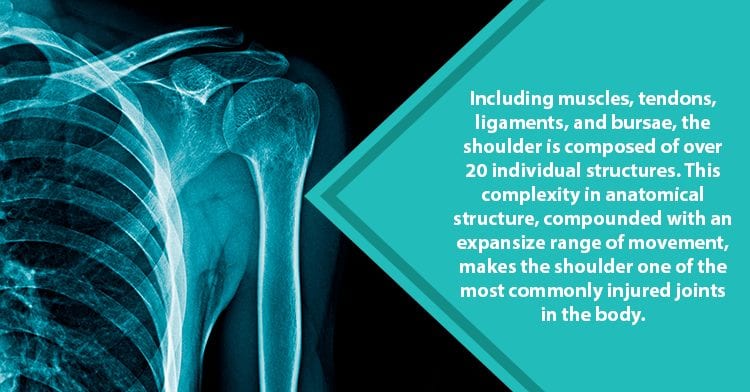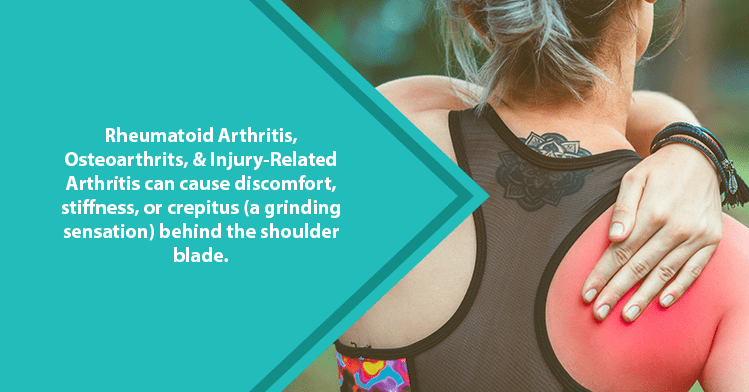Your shoulder has earned its reputation as one of the most versatile and active joints in the body. With a synovial ball-and-socket design, this joint comes together where three major bones converge. The spherical head of the upper arm fits into a shallow divot in the shoulder blade and receives anterior support from your collarbone. However, these bones cannot maintain the structural integrity of your shoulder alone. To aid in this endeavor, your bones rely on the support of numerous muscles, ligaments, tendons, and protective bursae. For example, your rotator cuff—a system of tendons and muscles—provides the structural stability required for movement. And boy, can our shoulder move.
Arm movements forward, backward, above the head, across the body, out to the side, and rotation of your forearm… Your shoulder joint initiates all of these movements. Undeniably, this agility—combined with the sheer volume of supportive anatomy—permits much movement, but also, much opportunity for injury. And, with injury, comes numbness, tingling, immobility, and yes, pain. Let’s take a look at 7 of the most common causes of shoulder pain.

Common Shoulder Disorders
- Bursitis: With over 150 bursae in the body, 5 can be found in the shoulder. Furthermore, these protective, friction-absorbing discs sit between muscle and bone, as well as tendons and bone. When excessive pressure or repetitive movements induce strain on these bursae, they can become irritated, inflamed, or painful. Activities such as tennis, baseball, repetitive lifting, or performing chores on your hands and knees can lead to shoulder bursitis. Specifically, pain felt on top of the shoulder, swelling, and tingling can all be signs of shoulder bursitis. In fact, persistent or untreated bursitis can even lead to Rotator Cuff Tendinitis.
- Rotator Cuff Tendinitis: Composed of fibrous collagen, tendons function as connective tissue to attach muscle to bone. Because of this function, our tendons can facilitate a diverse range of movement in our shoulder. Rotator Cuff Tendinitis can materialize when the tendons in the shoulder become irritated, inflamed, or develop small tears. Sudden, jerky movements; repetitive strain associated with jobs that involve lifting; even cleaning the house can all lead to tendinitis.
- Frozen Shoulder: Frozen Shoulder is a progressive condition of which the exact cause is unclear. As has been noted, the ball-and-socket joint of the shoulder comprises many diverse structures. For example, a host of tendons, ligaments, and bursae cushion and bind together the three main bones of the shoulder. With age, these surrounding tissues, in particular the ligaments, can lose flexibility and become tight. Called frozen shoulder, this condition can progress and intensify over a long period of time. In fact, sometimes frozen shoulder can last for as long as 3 or 4 years. Typically, this condition will begin with pain in the shoulder, often felt in the muscles on top of the joint. Over time, this pain will be accompanied with stiffness and immobility.
- Pinched Nerves (Radiculopathy): Pinched nerves, especially those occurring in the neck, can lead to a host of concerning symptoms in the shoulder. Nerves in the cervical spine can become compressed as a result of bulging or herniated discs, bone spurs, neck injuries, or conditions such as spondylolisthesis. And, since many cervical nerves branch out to feed the muscles and tissues of the arm, radiculopathy can easily occur. Radiculopathy, or radiating nerve pain, can result in muscle cramps, tingling, burning, and numbness in the shoulder.
- Instability (Dislocation): Doctors use the term, shoulder instability, to describe a loose shoulder joint that can easily dislocate or slip of place. Extreme blows to the shoulder—such as the forces exerted during falls or car accidents—can result in shoulder dislocation. In addition, another common cause of shoulder instability includes excessive flexibility or structural weakness of the rotator cuff. Similarly, degeneration of the joint due to overuse or disease can also weaken the shoulder joint. Furthermore, following the first dislocation, second and third dislocations become more common and often occur with less force. An unstable shoulder can be fraught with pain or the sensation that your joint could slip at any moment.
- Arthritis: A degenerative condition that attacks the joints, arthritis targets the tissues that we use the most regularly. Because of this, the shoulder is particularly susceptible to the effects of arthritis. Common types of arthritis in the shoulder include Rheumatoid Arthritis, Osteoarthritis, and Injury-Related Arthritis. Symptoms may involve pain, burning, a grinding sensation, stiffness or immobility, and incapacitation of the joint.
- Fracture: Fractures in the shoulder can occur in any of the three major bones in the joint. However, these breakages affect the collarbone and shoulder blade the most often. Falls and high-impact collisions such as car crashes, for instance, can cause your shoulder blade to fracture upon impact. In addition to pain, fractures can lead to localized swelling, and in severe cases, shoulder immobility
By and large, the symptoms for each of the above conditions resemble one another. The primary difference lies in the trigger of the symptoms. For a definitive diagnosis, contact a physician whom you trust to evaluate your pain. A board-certified orthopedist can provide you with an accurate diagnosis and effective treatments to get your shoulder feeling better again!




